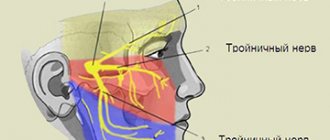Symptoms and signs
The symptoms are very similar to those of discirculatory encephalopathy (sometimes even these terms are used as synonyms, although this is incorrect):
- Headache.
- Dizziness.
- Memory loss.
- Mood swings.
- Sleep disorders.
- Noise in the head.
- Throwing to the sides while walking.
- Nausea, etc.
Signs may also include decreased hearing, decreased vision after excluding pathology by an ENT doctor and an ophthalmologist.
Prevention of atherosclerosis
Prevention of atherosclerosis is based on changing a person’s lifestyle. It is necessary to regularly attend scheduled examinations with your doctor. The following help slow down the development of atherosclerosis or reduce the risk of its development:
- proper and balanced nutrition;
- weight normalization;
- giving up bad habits (smoking, drinking alcohol);
- moderate physical activity;
- walks in the open air.
You also need to avoid stressful situations, overwork, and emotional stress.
Diagnostics
Diagnosis of the disease is based on vascular studies (REG, ultrasound, angiography), neuroimaging techniques (MRI, MSCT). According to research data, the presence of plaques and calcifications in the vessels is determined. It is also possible to identify the presence of areas of turbulent (vortex) blood flow.
Sometimes the diagnosis is made based on a biochemical blood test for cholesterol and its fractions with the calculation of the atherogenic index. In the presence of a high atherogenicity index (above 4) and a confirmed fact of long-term dyslipidemic changes (performing dynamic tests), it is possible to diagnose cerebral atherosclerosis without additional examination.
Treatment of cerebral atherosclerosis
Treatment of atherosclerosis includes taking special medications - statins, which lower cholesterol in the blood. Vasodilators are also prescribed to improve blood flow. In more severe cases, surgical intervention is performed, as a result of which the vessel is replaced or expanded.
Since blood supply plays a major role in all tissues and organs of the body, vascular atherosclerosis can lead to the occurrence of many other diseases, the most dangerous of which is coronary heart and brain disease. With these diseases, the patency of blood vessels and coronary arteries, which are vital for the body, is impaired. Without effective treatment, patients can suffer from stroke and heart attack.
Treatment
Therapy of the disease is carried out at the junction of general practitioners and neurologists. Drugs that normalize lipid metabolism are used. More often than others, statins are used (atorvastatin, simvastatin, rosuvostatin, etc.) under the mandatory control of many biochemical parameters (ALT, AST, creatinine, in fact, the level and ratio of cholesterol fractions). The dosage and duration of taking the drugs is selected individually.
If there is stenosis of the arteries of the head or neck of more than 70%, severe symptoms, or the presence of episodes of transient ischemic attacks, surgical intervention is possible. Plaques are removed and arteries are stented.
Dopplerography of blood vessels
What is Dopplerography? This is a safe and effective method of examining blood vessels to identify pathologies and vascular diseases. With its help, the places of vasoconstriction, the location of vascular plaques and malformations (congenital anomalies or disorders in the structure of the vessel) in the arteries are determined. The procedure is painless and harmless (ultrasound does not disturb the tissue structure) and does not require preparation.
Doppler ultrasound is indicated for any disorders associated with blood circulation and is performed for the vessels of the head and neck, heart, lower and upper extremities. To conduct the examination, the patient lies down on a couch. The doctor applies a special gel to the area to be examined and touches it with an ultrasound sensor. The resulting image is displayed on a computer monitor. The procedure does not cause discomfort, and the duration of duplex scanning depends on the number of study sites. On average, the examination lasts no more than half an hour.
Prevention
All patients with cerebral atherosclerosis need a diet. The diet requires strict control of the intake of animal fats (butter, lard, fatty meat, etc.), sugar (confectionery, sugar, sweet drinks, etc.), offal and semi-finished products. Whenever possible, such foods are excluded from the diet or significantly limited. Preference is given to seafood, vegetables, and cereals.
Prevention also involves regular preventive examinations and medical examinations with the possibility of timely detection of lipid metabolism disorders and the prescription of medications. To prevent possible consequences of the disease, it is important to prescribe adequate antihypertensive therapy, because it is the combination of atherosclerosis and high blood pressure levels that most often lead to conditions such as transient ischemic attacks and ischemic strokes.
Atherosclerosis: why men get sick more often
Atherosclerosis is one of the most common cardiovascular diseases. It is the leading cause of coronary heart disease, which, in turn, increases the risk of myocardial infarction, increasing the number of cases of disability and mortality among the adult population. According to statistics, approximately 75% of men at the age of 30 begin to develop atherosclerosis, and this is 2 times more than if we were talking about women. Why do the stronger sex get sick more often?
Risk factors
Common risk factors for the development of atherosclerosis are: hormone imbalance, high blood pressure (greater than 140/90), high blood cholesterol, diabetes, smoking, alcoholism, poor diet, obesity, stress and a sedentary lifestyle. Of course, these factors are also present in women, but in men they are much more common. Let's figure out why this happens.
Hormonal imbalance
One of the most important male hormones is testosterone. It is responsible not only for reproductive function, but also regulates the activity of many other organs and tissues. For example, it promotes the production of nitric oxide, which lowers blood pressure and helps a man live longer. Scientists have found that the more of this hormone in the blood, the lower the risk that a person will develop hypertension, type 2 diabetes and obesity, and therefore atherosclerosis. By the way, the more testosterone, the less prone to depression, and depression also contributes to the development of atherosclerosis.
Read also: Cardiovascular diseases
Unfortunately, testosterone in a man’s blood decreases noticeably with age. It is believed that this process starts at the age of 30. Thus, men, before reaching old age, are already deprived of one of the factors that protect them from atherosclerosis. “But why are women not at such risk? - you ask. “How do they live their entire lives with lower testosterone levels?” Everything is very simple. Women have their own sex hormones in their blood - estrogens. They protect the body from atherosclerosis until the onset of menopause.
Arterial pressure
Men's blood pressure is usually higher than women's for physiological reasons: the size of a man's heart is larger than a woman's, the heart rate is higher, and the walls of blood vessels are thicker and therefore less elastic, which also contributes to higher blood pressure.
The longer a person suffers from arterial hypertension, the more irreversible the changes in blood vessels become. American scientists have proven that the life expectancy for a 35-year-old man with a blood pressure of 120/80 mm Hg. will be 41 years old, and with blood pressure 150/100 mm Hg. - about 25 years old.
Psychological characteristics
We must not forget about the personal qualities that distinguish men from women. There is often a misconception among middle-aged men that measuring your blood pressure and cholesterol is an unnecessary concern about your health. Men may be afraid of appearing “weak” and defenseless, and consider worrying about health to be shameful. They are more likely to ignore doctor's orders or not take them seriously.
In addition, men are more susceptible to stress and psycho-emotional factors. According to surveys, men endure traumatic situations such as divorce, quarrels, intra-family and work conflicts much more difficult. In addition, representatives of the stronger sex believe that it is impossible to talk about their problems, they hush them up by pouring large doses of alcohol, and going to a psychologist is out of the question. Men are often ashamed to reveal their state of mind to a specialist.
Lifestyle
Another feature of the male gender is a low commitment to a healthy lifestyle. The reluctance to think about health and “drowning” stress was mentioned earlier, but this is not all. Men, especially over the age of 45, are more likely than women to lead a sedentary lifestyle, spend their leisure time lying on the couch, forget about running in the morning and swimming in the pool, and do not follow a diet. The stronger sex is also more likely to drink alcohol, fatty foods, fast food, and smoke tobacco. The risk of developing obesity in men is higher, and this is confirmed by statistics - in Russia there are more and more overweight men.
From all of the above, we can conclude that men are targets for a greater number of risk factors than women, which means that their chance of developing atherosclerosis in their vessels, unfortunately, is much higher.
What should you do to protect yourself or a loved one? Unfortunately, in this case, hardly anything can be done “without the patient’s knowledge.” A man’s health is primarily in his hands. If you reduce at least one of these risk factors, the likelihood of atherosclerosis will become significantly less. This is also facilitated by regular consultations with a cardiologist.
Alexander Spiridonov
Photo depositphotos.com
Diagnosis of atherosclerosis
All diagnostic measures begin with collecting anamnesis and physical examination of the patient, measuring his blood pressure. If necessary, the person is weighed (to calculate the body mass index).
To diagnose vascular atherosclerosis, the following are prescribed:
- biochemical blood test (lipid profile: total cholesterol, LDL, HDL, triglycerides + less often VLDL, LDLP);
- ECG, ECG with exercise (Veloergometry);
- 24-hour ECG monitoring in 12 leads;
- ECHO-CG (ultrasound of the heart and aorta);
- duplex and triplex scanning of arteries;
- magnetic resonance angiography;
- MSCT with contrast of arteries;
- CT scan to determine the accumulation of calcium in the arteries of the heart;
- X-ray contrast examination of the arteries (coronary angiography).
1 Laboratory diagnosis of atherosclerosis: testing
2 Laboratory diagnosis of atherosclerosis: testing
3 Pressure control in atherosclerosis










